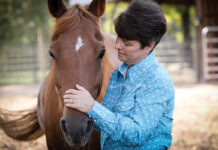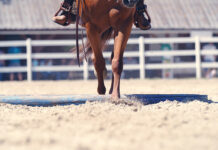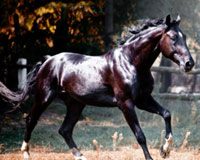It’s a universal truth of horse ownership that the dirtier you get, the cleaner your horse becomes. There are no real shortcuts to a well-groomed horse, but you can optimize your results by grooming smarter. Here are some horse grooming secrets keep your horse looking great.
Horse Grooming Secret #1: Get a Shiny Coat
If you’re going for the gleam, make good use of your curry comb. Currying removes deep-down dirt, promotes circulation and helps distribute the natural oils in your horse’s coat. Plus, it’s like a mini-massage for your horse.
Rubber curry combs come in a variety of firm or flexible textures. Select one that your horse finds comfortable, and curry in small circles over your horse’s body. Follow with a medium-stiff brush, using short, brisk strokes with an upward flick to lift the dirt and loose hair you’ve brought up with your curry session. Finish with a soft brush to bring up the shine in your horse’s coat.
Although it’s not a replacement for currying and brushing, coat polish spray can also play a role in Project Shine. Beyond adding the final touch on show days, regular use can cut your grooming time and keep your horse looking fabulous. Used once or twice a week, it will make your grooming job last longer by repelling dust and can also help prevent stains on light-colored coats. Avoid spraying the saddle area though—these products make the coat slick and can cause your saddle to slip.
To achieve a truly healthy shine, your horse needs quality nutrition. Talk to your vet or an equine nutritionist to make sure your horse is on an optimal feeding plan. Supplements for skin and coat health can also help a challenging case with a blend of ingredients including fats, vitamins and biotin to support hair growth and shine. Or, simply adding a little vegetable oil to your horse’s feed—gradually working up to 1 cup—can help boost the bloom in your horse’s coat.
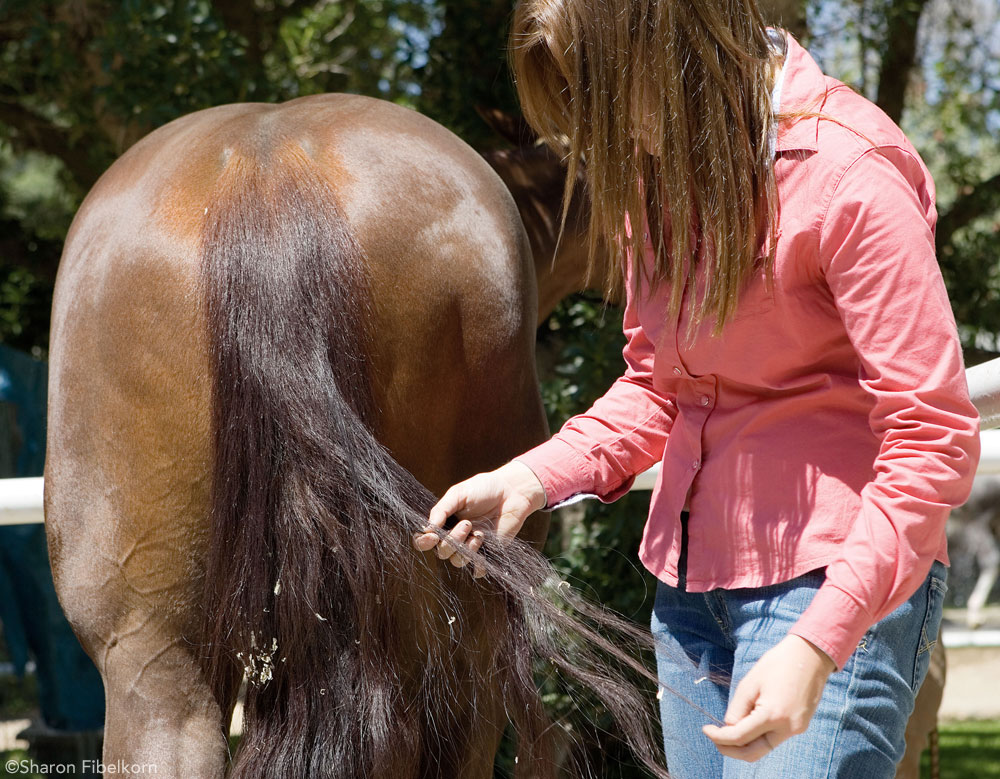
Horse Grooming Secret #2: Unravel a Tangled Mane or Tail
The gentlest way to detangle is to do it by hand, although you can also use a wide-tooth plastic comb. A mane and tail detangler makes the job easier so that the strands of hair slip apart without snagging and breaking. Many coat polish spray products also double as detanglers.
Apply the product evenly through the hair. Then start detangling from the bottom of the hair, working your way up. Work in small, manageable sections. To remove burrs, foxtails and large knots, apply detangler directly to the problem areas.
Once you can easily run your fingers through the hair, you can use a brush or comb if you wish. Many people believe that brushing is the worst thing for a tail, while others feel that brushing helps promote circulation at the roots, therefore promoting growth. If you opt to brush, choose a flat-backed brush with widely spaced, soft-tipped pin bristles. Hold the hair in one hand close to the top in order to avoid pulling on the root, and then brush below—again, working from the bottom up.
Horse Grooming Secret #3: Long, Luxe Locks
If you want your horse to have a long, glorious mane or tail, your goal is to minimize breakage. Avoid excessive brushing or combing. This is one case where less can be more: the less you handle the hair, the more precious strands you’ll preserve.
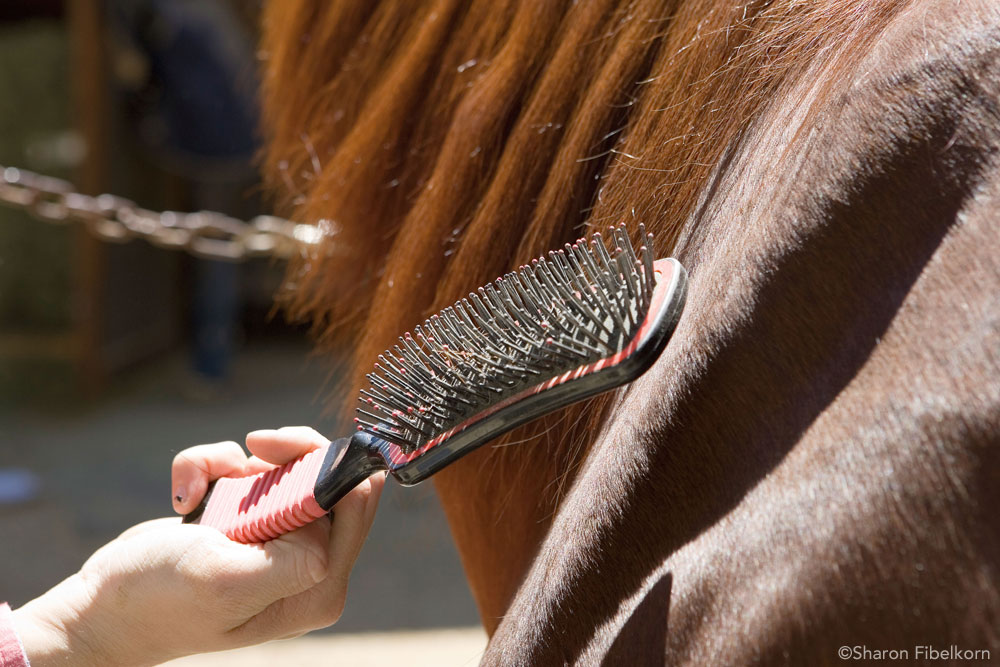
Remove debris, such as shavings and hay, from the hair daily. You can do this by hand, or a quick shake may be all that’s needed. Regular detangling (Tip #2) will keep major dreadlocks from forming and make the hair easier to maintain.
Keeping the mane and tail clean encourages growth as well. Shampoo weekly, scrubbing down to the roots. Be sure to rinse thoroughly. Follow with conditioner, focusing on the ends of the hair. Let the hair dry completely before combing or working with it.
To protect a long, full mane from snags and tangles, braid it in thick sections. Keep the braids loose at the crest so they don’t itch and encourage your horse to rub his mane. Redo the braids as needed, or once a week after shampooing and conditioning. A long mane requires regular care to look good and encourage growth, but the results can be spectacular.
Horse Grooming Secret #4: A Terrific Tail
The length and thickness of your horse’s tail is largely genetic, but a little pampering can help it reach its full potential.
A popular tail-maintenance technique is to braid the hair or put it in a protective tail bag to keep it clean and tangle free. Braid in a single loose plait below the tailbone. A tail bag attaches through the braid. Never fasten a tail bag over or around the tailbone, where it could cut off circulation. At the height of fly season, keep in mind that braiding and bagging will diminish your horse’s defense against bugs. This may prove problematic for pastured horses but be less of an issue for horses that live in a stall.
Tail rubbing is a major equine beauty buster that drives horse owners crazy. Possible causes include dry, itchy skin; parasites (pinworms); and the allergic reaction known as “sweet itch,” caused by hypersensitivity to insects. Soothing shampoo, targeted deworming and ramping up fly control measures are simple solutions to start with in these cases. Other types of skin and contact allergies can cause horses to turn to tail rubbing as well. Severe cases will likely require diagnosis and medication prescribed by your vet.
A dirty sheath or udder can also result in tail rubbing. Since horses can’t scratch these places, they’ll rub their hind end for relief instead. Click here for sheath cleaning instructions.
Horse Grooming Secret #5: A Tidy Trim
Some light cleanup work with the clippers will take your horse’s look from shaggy to sleek. Trimming the long hairs under his jawline, the shaggy feathers at his ankles and the tufts of hair sticking out of his ears creates a well-groomed appearance. High-level competition often calls for a more stringent standard of trimming, but this isn’t necessary for most horses.
Small clippers with a No. 10 blade are sufficient for this simple trimming job. Make sure your horse will tolerate the sound and feel of the clippers before you start. You’ll be mainly clipping with the direction of the hair growth to remove just the longest hairs for a blended appearance. (Clipping against the growth gives a closer shave.) However, when trimming your horse, you may find that you need to turn the clippers and brush over the top of the hair at an angle in order to blend it.
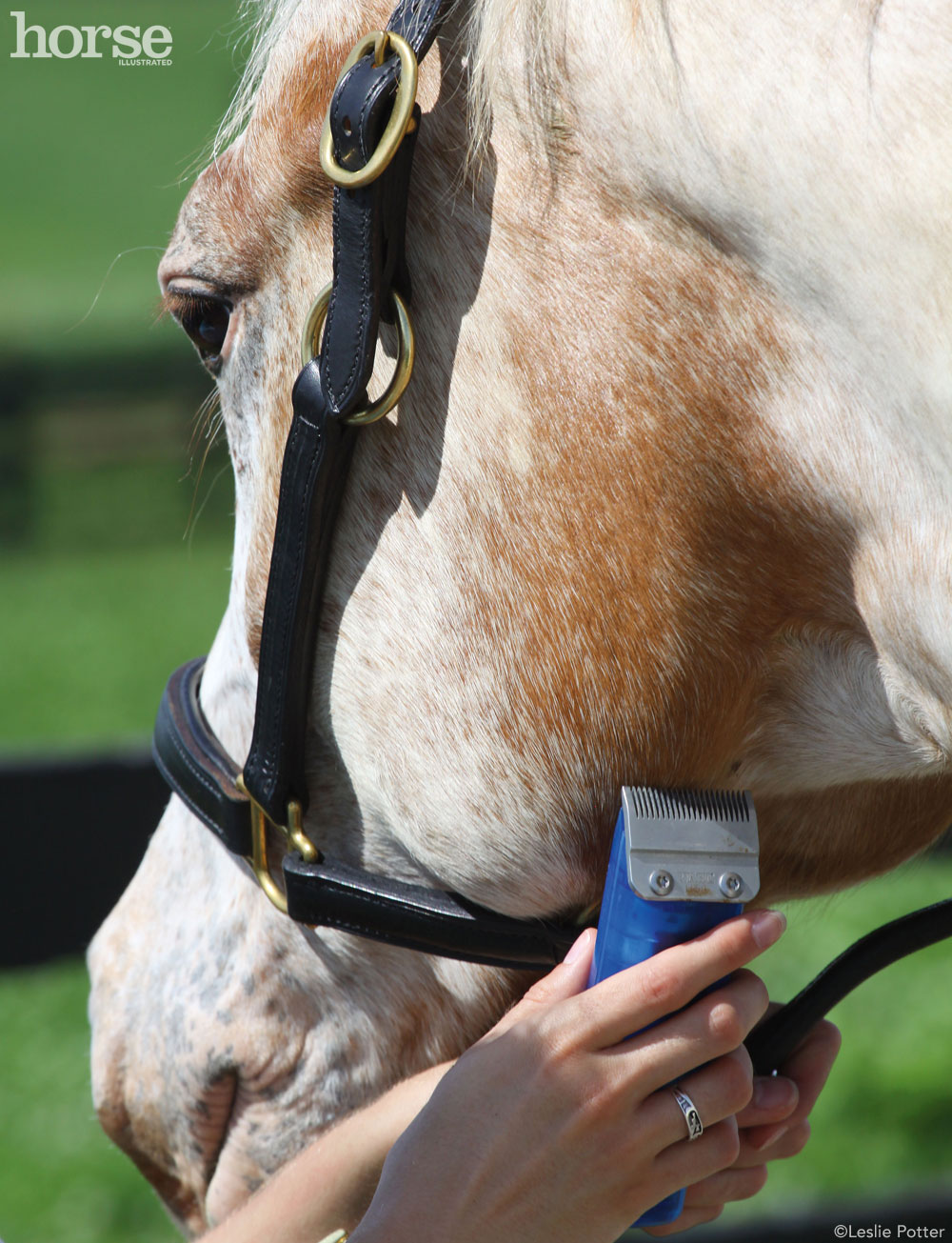
To trim the billy-goat beard under your horse’s jaw, run the clippers underneath in the direction of the hair growth from between his jowls to the groove in front of his chin. Angle the clippers as needed to get all the hair and blend it at the edge of the jawline.
Clean up shaggy fetlocks and long, wispy hairs on the back of your horse’s legs using the clippers with the direction of the hair. Turn the clippers to scoop out all the shag underneath the fetlock joint and behind the pastern.
The hair in your horse’s ears provides protection from bugs and gnats in summer and offers warmth in winter, so it’s best to not remove too much if your horse lives out on pasture. Hold the ear in your hand, gently press the sides together and remove the long hairs that protrude beyond the edge of the ear with your clippers. This levels off the hair inside the ear with the outer edge.
Trimming a bridle path will also give your horse a neater look by removing a little mane behind the ears, where the crownpiece of the bridle sits. You can use either clippers or small scissors for the job. Be careful not to get carried away and cut into the forelock or go too far down the neck, unless that’s the preferred style for your breed or sport. Otherwise, the bridle path is usually just a few inches long to easily accommodate the width of your bridle.
The whiskers on your horse’s muzzle have some sensory function, so many horse owners opt to leave these little feelers. Other horse owners find them untidy and clip them off. For the show-ring, a clean-cut look is expected in most arenas. A happy medium is to leave the whiskers but trim them for shows or special occasions.
Horse Grooming Secret #6: Bathing Beauty
Keep your horse’s comfort in mind and make bath time as easy as possible on him. Warm water will be appreciated by your horse if it’s available, and also opens the hair shaft to make your cleaning efforts more effective. An adjustable spray nozzle lets you dial the water pressure down for your horse’s sensitivity level as needed, and increase it for more efficient rinsing.
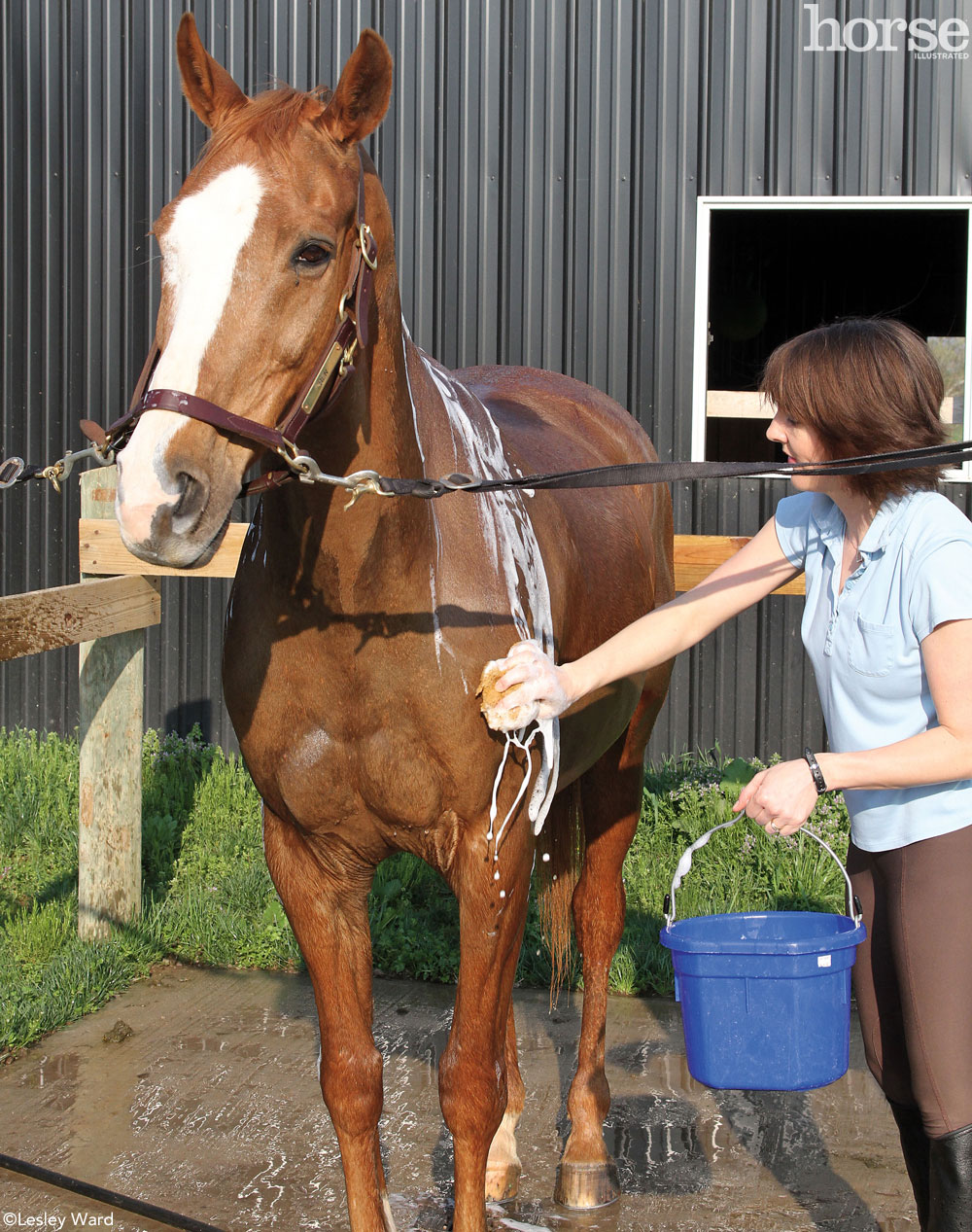
Diluting the shampoo in a bucket makes it easier to rinse from your horse’s coat. Some equine shampoos are concentrated and designed to be diluted before use, so read the directions on the product you are using. Also realize that more shampoo doesn’t necessarily result in a cleaner horse. Start with a small amount, and create more suds as needed. Work the shampoo down to the skin with a curry mitt or your fingers for a deep clean—that’s the secret. You can apply shampoo full-strength directly to the mane and tail.
It’s usually not necessary to use shampoo on the face and head. You don’t want to get soap in your horse’s eyes, and it can be difficult to rinse out completely. A damp towel or sponge should be sufficient to clean your horse’s face. For light-colored heads or white markings that need deeper cleaning, dip a sponge in diluted shampoo and follow up with a clean, damp rag to rinse.
Never use dish soap or other harsh detergents to bathe your horse. These will strip the oils from the coat and possibly irritate his sensitive skin. Equine shampoos and conditioners are formulated with a gentle pH while also being equipped to handle horses’ coarser haircoats and the tough dirt they get into.
It’s crucial to rinse well. Soap left in the coat dries it out, can cause itching and dandruff, and leaves a dull finish instead of the bright and shiny glow you want. To make sure your horse’s coat is soap-free, rinse and then use a sweat scraper to squeegee excess water from the coat. If you see soap bubbles, rinse and repeat until the water runs clear.
Hand graze your horse in the sun or leave him tied until he dries. If you put a wet horse back in his stall or field, the first thing he will naturally want to do is have a good roll, undoing all of your hard work. To repel stains from your horse’s clean coat and add extra shine, apply coat polish spray while he’s still damp.
Horses don’t require a full bath that often. A rinse with plain water will usually suffice to remove dirt and sweat after a workout. If you bathe your horse frequently, use a gentle shampoo designed specifically for horses, and follow with a conditioner as well. Conditioners strengthen the hair, restore moisture and smooth the coat to increase shine.
Horse Grooming Secret #7: Whiter Whites
Keeping your white or light-colored horse clean is a major grooming challenge. White socks and markings also require extra effort to stay sparkling. To keep stains from setting into the coat, keep up on regular grooming. Use waterless shampoos and spot removal products when bathing isn’t possible. Just spray on and use a towel to lift the stain. Simple spot cleaning with a bucket and sponge works too.
A specially formulated whitening shampoo will be your best friend in the wash rack. These shampoos usually have a blue or purplish tint to counteract the yellow cast a stained white coat often takes. Read the product directions carefully. Some whitening shampoos need to be left on, while others could leave a purple tint behind if too much is used or if they are left in the coat too long. Apply the shampoo as directed and scrub well for best results. Stubborn tail stains may require several sessions with a whitening shampoo to come clean. If your pony does turn purple, don’t panic. The excess color should scrub out with regular equine shampoo.
This article about horse grooming secrets originally appeared in the 2014 issue of Your New Horse, from the editors of Horse Illustrated. Click here to subscribe!

